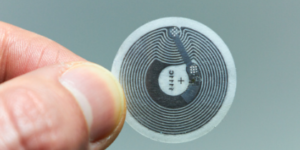Retailers require accurate item-level inventory data to increase sales and reduce costs. RFID-enabled retail allows retailers to replace assumptions with observations, estimates with actuals, and uncertainty with certainty.
 Nongrocery retailers using RFID to improve operational use cases are increasingly common due to omnichannel sales growth and evolving customer demands, saving time, boosting productivity, and shifting associate priorities according to customer demands.
Nongrocery retailers using RFID to improve operational use cases are increasingly common due to omnichannel sales growth and evolving customer demands, saving time, boosting productivity, and shifting associate priorities according to customer demands.
Inventory Management
Retailers looking to reduce inventory inaccuracies and improve stock visibility find RFID an ideal solution, typically seeing 3-4 per cent sales increases upon adopting an RFID-enabled retail inventory process.
Staff no longer need to count items by hand since mobile device scans allow instant inventory accuracy and are updated regularly – giving managers insight into exactly how many products are for sale at any given time. Warehouse and DC workers receive product-location data supporting picking, replenishing and reordering operations more effectively; when physical inventory matches supply chain data more closely, out-of-stocks and overstocks diminish significantly.
Self-Checkout
Utilising RFID-enabled retail can make the self-checkout process of stores more efficient than using traditional barcode scanners; one nine-item purchase took 90 seconds, while it took under 10 seconds with an RFID-enabled self-checkout system.
Retailers can utilise RFID to enhance in-store experiences. Kendra Scott used RFID-powered scanning in its Color Bar to trigger an engaging jewellery customisation experience that increased engagement and customer satisfaction twofold.
Retailers can improve inventory accuracy and lower labour costs by decreasing cycle counts and automating replenishment, thus helping avoid out-of-stock situations and shortening physical inventory counts. They can set safety stock levels without manual spot checks, alerts automatically without manual spot checks, and use RFID to locate missing items using EAS data combined with sales data and video footage for shoplifters to be identified – sharing this data with authorities for prosecution if something goes missing!
Buy Online / Pickup In-Store
As retailers recover from the COVID-19 pandemic, investments made during its crisis are beginning to pay dividends regarding customer experiences created and enabled omnichannel shopping. RFID technologies, in particular, are proving invaluable.
Retailers use RFID to improve inventory accuracy throughout their stores and supply chains, from initial shipments through final sales. Significant major retailers even tag their goods and shipments as enforced compliance with supplier guidelines – commonly called a “tag mandate.”
RFID systems not only reduce manual labour by streamlining checkout, but they also offer greater visibility into stock levels. When an item–whether sold or stolen–walks out the door, RFID will immediately alert employees, helping prevent out-of-stock and shrink events.
Inventory Visibility
Inventory inaccuracies are costly to retailers who struggle to maximise the full potential of their physical stores. RFID can improve inventory accuracy to avoid these inaccuracies and enable more precise reordering, replenishment, and order-picking planning.
RFID allows employees to take inventory more quickly and accurately, making it easier to meet buy online/pickup in-store (BOPIS) fulfilment needs and omnichannel fulfilment demands. Furthermore, it helps prevent lost items from going unnoticed by employees taking inventory more frequently.
Integrating an RFID solution into their cloud-based point of sale enables retailers to offer self-checkout, improve customer satisfaction and loyalty, speed up checkout processes, and track items that have been picked up for try-on or purchased but never returned in order to prevent theft and loss prevention and identify high traffic areas or pinch points within stores where merchandise movement occurs as well as notify loss prevention specialists when theft has taken place.
Enhanced Marketing
RFID technology is a game-changer when it comes to inventory control, making it easier for retailers to hit their operational targets. Unlike barcodes that require line-of-sight scanning, RFID tags can be scanned quickly and from a greater distance, speeding up inventory counts and allowing employees to focus on other tasks.
Several retail sectors can benefit from the improved tracking capabilities of RFID. For example, RFID is commonly used in electronics and consumer electronic stores to help prevent theft and enhance inventory management. RFID is also often incorporated in jewellery and luxury goods to improve security and offer product authentication. In office supply stores, RFID helps streamline stock counts and reordering processes.
In stores, RFID-enabled smart shelves can automatically detect low or out-of-stock items and trigger alerts, reducing missed sales opportunities. RAIN RFID can also enable personalised customer engagement experiences. For instance, in a fitting room, an RFID-enabled mirror can display product details and recommendations on screen.